What can you do to avoid creating content that achieves zero ROI?
We’re all doing it. Feverishly churning out blog posts, video tutorials, how-tos, podcasts and infographics. Content is king, right?
But do you know why you’re creating content?
Is it because everyone’s doing it, your boss has mandated it or because your competitors are?
Is it because you have a product to sell and you want to tell people why they should buy it (in a lot of words)?
Maybe you’re creating content because it’s ‘free’ and you’re working on a tight budget.
If there were checkboxes next to those answers, and you would have ticked one or more of them, we need to talk.
To create content that converts, you must rigorously consider your answers the three following equally important questions:
- Who cares?
- Where’s it going?
and
- What’s the goal?
Who Cares?
Everyone’s creating content, but who is it for?
Maybe you have a topic burning a hole in your pocket that you think will knock punter’s socks off, and it might, but you might also spend hours writing a comprehensive whitepaper or spending your hard-won marketing budget on a beautifully designed infographic that no one ever sees.
In 2020, Ahrefs studied 1 billion pages to work out how many indexed pages had page views. The upshot? 90.63% of the time no one views the content. And of the 9.39%, just 4.09% attracted 11+ visits.
How do you avoid that depressing fate?
Do your research!
There are so many simple ways to find out what people care about.
1. CONSULT YOUR ANALYTICS
Your own social media and Google Analytics accounts are a great place to start.
Social platforms generally have an ‘Insights’ section that reveals which pieces of content have achieved the highest reach and what the engagement numbers have been across likes, shares and comments (see image at right).

Google analytics is a goldmine, too.
Find out which blog posts or content pieces are top and lowest performing based on page views, bounces, value, etc., by navigating to ‘Behaviour’ > ‘Site Content’ > ‘All Content’.
To view only blog pages, for example, use the path name, e.g. /blog is the path here: https://indagodigital.com.au/blog/content-that-converts.
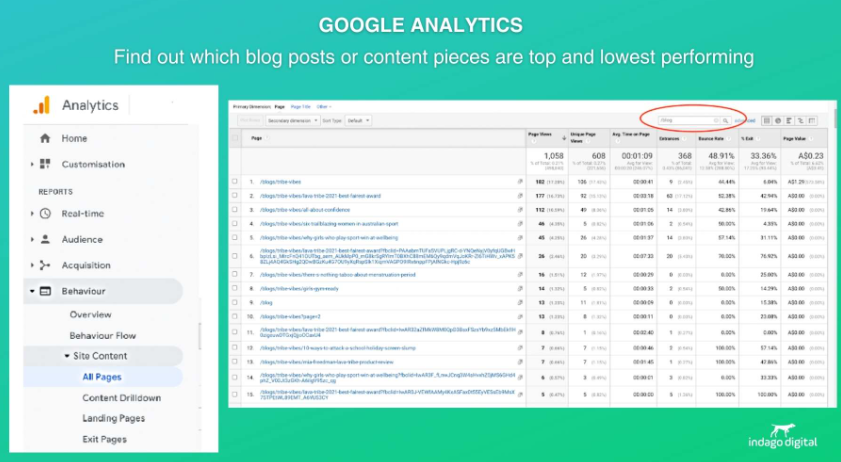
1. Connect with your networks
Ask your clients, networks and colleagues; seed a discussion on your socials to see if the topic sparks a conversation or pose questions on platforms like Quora, Yahoo!, Reddit or industry-specific forums.
2. Find out what people also ask (PAAS)
Most search engine results pages (SERPs) will feature a ‘People Also Ask’ section.
Say I’m interested in writing about fairy bread as a theme (because who isn’t interested in fairy bread, right?)
To find out what sort of queries are commonly searched for, I type ‘fairy bread’ in as a search query on my search engine of choice and viola! I discovered that these are the top things that people want to know:
- Why is it called fairy bread?
- What does fairy bread taste like?
- What do they call sprinkles in Australia?
- When should you eat fairy bread?
These are all solid content ideas, and they’re based on actual search queries. You can use it to craft content that engages and scratches the reader’s itches.
Another simple, related hack is to...
use Google’s autofill function for ideas. Again, if I return to the fairy bread example, Google gives me these suggestions for terms I might like to search.
(‘Fairy bread petition’ was especially entertaining and, yes, there is a ‘Fairy bread day’. It’s on November 24, and I am hereby observing it every year.)
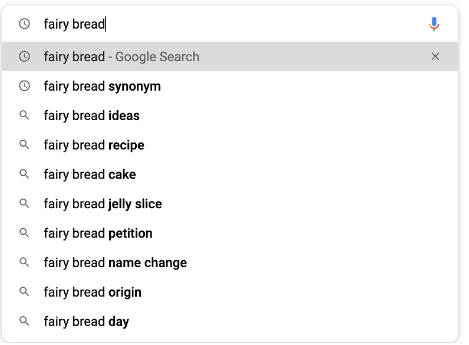
3. Get on the tools
There are a bunch of excellent content research tools available to help you drill down on what people care about.
Google Trends is a free resource that shows you related topics, related queries and interest by region. You can search right back to 2004.
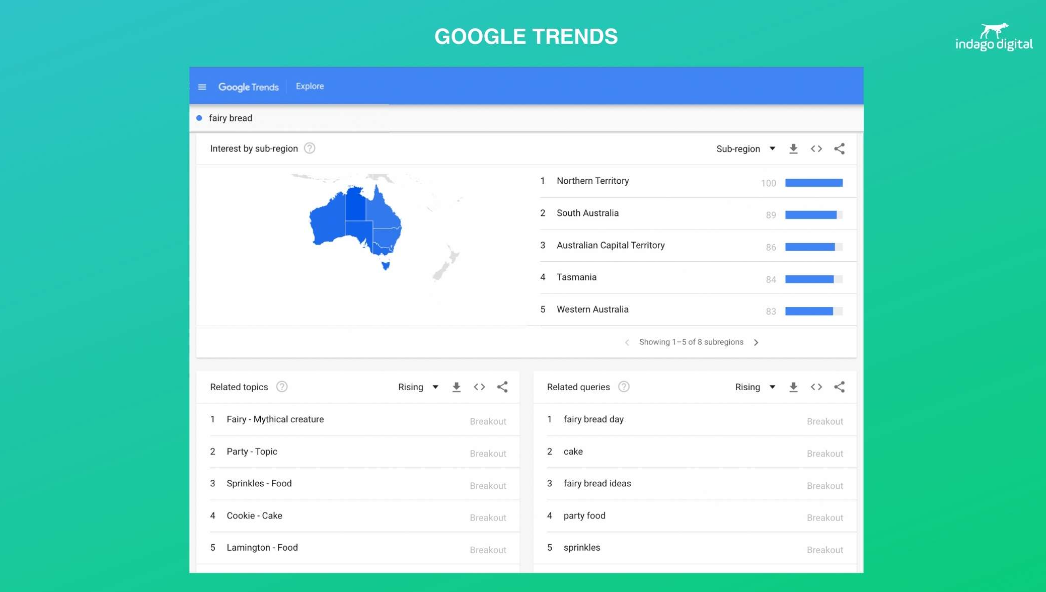
Answer the Public is another free tool that groups search terms into ten subsections based on query types like ‘what’, ‘why’, ‘where’ and ‘how’.
Buzzsumo is probably the best for content marketing research. There are paid content research tools aplenty, like Ahrefs and Semrush, but you can search for any keyword (e.g. ‘fairy bread’), and Buzzsumo will show you the most shared content relevant to the keyword. It also shows you how these keywords perform across social channels, who has shared the content the most and who is linking to it. This is a treasure if you’re working on a link-building strategy and need outreach ideas for content distribution.
As well as thoroughly determining that the care factor is there (or tweaking your idea so it does), be sure to also think of your presentation. While your subject might cause your target people to stop their scroll, the way you present it will also make a big impact on whether or not they read beyond the first line. Weave images and GIFs into your blog content to boost interest, for example. According to BuzzSumo, blog posts with graphics placed every 75-100 words get twice as many social shares.
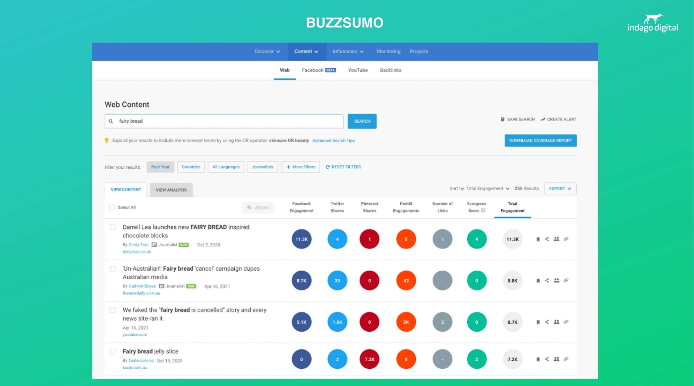
5. Adopt a multi-channel mindset
Sprout Social’s 2021 Social Index measured the way people like to consume content. They found that:
- 68% of consumers liked the images
- 50% engaged with videos
- 30% enjoyed text-based posts
The conclusion is that content creation has to have a multi-channel mindset.
As well as publishing your content on your site:
- Shoot a video of someone presenting it
- Repurpose it into a podcast, or share it with a relevant podcaster and ask to appear as a guest
- Use strong imagery that relates to the topic to support the text
- Create an accompanying infographic or case study
- Take a poll to gauge people’s responses to your topic
- Host a Facebook Live session to take Q&As
The opportunities to bring attention to your topic and content are endless.

How Will You Promote It?
There’s a standard line of thinking that views content as ‘free’, especially if it’s created in-house, but producing content always comes at a cost.
But, the fact is, it’s not. You must factor in copywriting, design, stock photography, videography, graphics creation and research. Those people take salaries even if you have these capabilities within your team. And if you stop there – at the point of design – and post it on your socials and publish it on your blog, the investment will likely earn you somewhere in the range of 0% return on investment.
We analysed content from 10 sites across various industries and discovered that the cost of content* ranged from $0.12 to $11.23.
EG. 1.
$0.12:Typically (and unsurprisingly), the sites that promoted their content through various channels fared better than those that didn’t. For example, the $0.12 site produces a range of different, but highly relevant pieces of content, it sits including guides, videos, webinars, and polls and shares the content via email and social media, leverages relationships with media and industry partners, and ensures that their content was keyword rich. They also produced new content frequently – at a rate of 3-5 pieces/ week.
EG. 2. $11.23:
The $11.23 site promoted their content (primarily blog articles) through emails and social media, but their approach was sporadic (every 2-3 months), and the content was generic. At $11.23 per page view, this site would likely achieve better results by investing in a paid media campaign.
* Based on unique page views and average content creation time of 4 hours per asset/ $50/hr
The quickest way to kill all your challenging content-creating work is to do nothing with it. Before you put pen to paper or book a videographer, think about how you’ll get this piece of content in front of the people who will benefit from seeing it.
Earned Media vs. Paid Media vs. Owned Media
Take stock of your owned media
- How can you deliver your message effectively across your social platforms?
- How do you avoid a one-size-fits-all brand persona? After all, your audience on LinkedIn, for example, is likely to differ from, say, Twitter or Facebook.
- What sort of shape is your mailing list in? Is your content something that suits everyone on your list, or do you need to segment your database to reach a niche? Can you make tweaks to your content to create a couple of different variations to speak to each segment’s sweet spot rather than blasting something generic?
- What about your blog? Which category or categories does it fit under for content-creating, and how can you create internal links and determine which keywords to use for a solid SEO benefit?
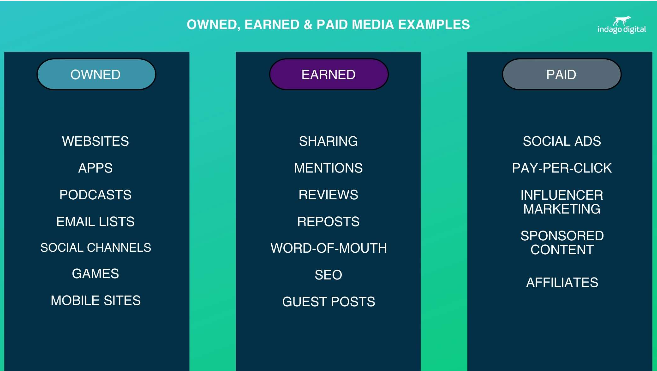
Get them talking (earned media)
Creating content with relevance to your audience in mind is critical. Still, it’s also well worth your while to consider the relevance to potential advocates – these could be industry publications, influencers, brand advocates, journalists, social accounts, and existing customers.
Connect with anyone aligned with your ideas and topics and motivate them to spread the word.
Get what you pay for (paid media)
According to a Semrush survey of over 1,500 marketers from different countries, businesses are increasing their content marketing budgets to achieve their content marketing goals.
There’s no sugar-coating it; better outcomes are achieved by promoting your content through paid social and pay-per-click (PPC) advertising than by relying solely on earned and owned media.
Outside of social and paid advertising, content marketers may also invest in influencer partnerships, event sponsorships, PR and the many (many) other activities and tactics that can help amplify your message.
What’s The Goal?
While 60% of businesses plan to boost their content marketing budget in the next 12 months, only 10% believe their content marketing is highly effective in meeting objectives (Fifth Quadrant, Creating Connections Report, 2021).
The good news is that we know where it’s all going wrong and how you can start to remedy it. The issue we see daily is that the objective is too sales conversion-focused, or it’s just not clear enough the cut through.
You MUST start with a goal and work back from your desired outcome for every topiece of content you produce.
Content marketing generally supports one of the following objectives:
- Brand Awareness
- Engaging Existing Clients and Prospects
- Search Engine Rankings
- Conversions
Let’s take a look at each one.
Goal: brand awareness
If you aim to raise brand awareness, push your sales KPIs aside. Brand awareness is best achieved by providing value based on your knowledge and experience; think how-to lists, educational videos, downloadable guides, tools, calculators, etc. Sure, you can add a call to action and sprinkle in a (hyper-relevant) service or product offering here and there – if you must – but, on the whole, you aim to reach people by demonstrating that you have authority on a topic that interests or helps them. Weave in an overt sales angle, and you can expect a mass exodus.
According to the Content Marketing Institute (CMI), 31% of content marketers consider blog posts the highest-performing type of content for building brand awareness.
To measure the brand awareness you’re achieving through content marketing, there are two key metrics you should keep an eye on.
Unique Page Views:
This metric refers to how many people viewed the page, excluding repeated views within the same session (i.e. visit to the site before closing/ exiting). This is the best measure of the traffic you’ve driven to your content, as it doesn’t count page views from people who might’ve refreshed the page or returned to it during the same session.
Entrances:
This metric measures how many people came to a page directly rather than clicking on it from another page on your site. This gives you an indication of how ‘clickable’ your content is off your page and how well the channels you’re using to deliver your content are working to promote it. A low entrance number compared to your page views means your traffic is being driven to the content from other pages on your site, and you have some work to do to broaden the distribution network for that piece of content to gain new eyeballs.
| Goal: Brand awareness | Key metrics: Unique page views + Entrances |
|---|
Goal: engaging existing clients and prospects
Content marketing is a great way to nurture prospects and retain and grow existing accounts. With third-party cookies being phased out, nourishing and developing relationships with people who have provided first-party data via a newsletter sign-up or have joined your social networks has never been more essential.
Using these channels, you can maximise the ROI a client perceives to have earned from their investment in your company. On top of that, you can upsell and cross-sell to an audience who already knows you can solve their problems.
Similarly, using your mailing list, LinkedIn, Facebook, Twitter, Pinterest and other ‘owned’ social media networks to engage prospects is an effective way to engage your warm prospects by educating, sharing wins, accolades and case studies, and promoting new products and services.
Open Rate/Click-Through Rate (CTR)
These are the metrics to use to measure the effectiveness of your email marketing activity. Open rate refers to how many people opened the email, and CTR refers to how many clicks it received.
Monitor your open rate to compare email campaigns over time and work out what the best day and time is to send your emails, what sort of subject lines perform and what the optimal frequency is to adopt between sends.
Drilling down into the clicks shows you what people are interested in and should guide your strategy regarding what content to create. Clicks on product or service-related content should be considered intent and followed up by sales to verify interest.
Shares/Comments/Likes (Engagement)
Use these metrics to measure the effectiveness of your social media content marketing. The most impactful of these is generally considered to be shares. If people are sharing your content, they value it. Also, by sharing, A follower turns into a valuable marketing channel of their own.
Comments allow you to start a dialogue with followers and build relationships and likes help to build social proof.
Combined, many shares, comments and likes signal to the social platform that the content is engaging, often boosting exposure.
It can be tricky to monitor engagement across various social media platforms, so it can be helpful to use a tool like Buzzsumo to track shares and determine which content is performing the best. There are also all-in-one social media platforms like SproutSocial that combine all your social channels into one dashboard and offer powerful engagement insights.
| Goal: Engagine existing clients and prospects | Key metrics: Open rate/ click-through rate (CTR) + Shares/actions/comments |
|---|
Goal: Search engine rankings
Focusing on keywords that help your site rank in organic search is a common and effective content marketing goal but it takes planning, research and dedication to quality to yield results. Remember that you are writing for the user first, not the robot, so don’t overuse keywords, duplicate pages or write meaningless content just to feature keywords you want to rank for – it simply won’t work.
A keyword plan should also be executed in conjunction with a link-building strategy if you really want to catapult your rank.
Use Google Search Console to monitor your average position in search results for all keywords as well as search results based on queries, pages, location and more. For more features like competitive analysis, backlink reporting and at-a-glance insights, look at paid tools like Moz, SEMRush and Ahrefs.
| Goal: Search engine rankings | Key metrics: Page rank |
|---|
Goal: Conversions
The most common measurement of success for content marketing programs is Total Sales at 62% (HubSpot, 2021). A sales goal for content marketing is an uphill battle from the get-go. Frankly, if you’re looking to drive sales, content marketing isn’t your best ally. It aids sales conversions, sure, but it rarely facilitates them in our experience.
Content marketing shouldn’t be salesy or agenda-pushing. Its purpose is to deliver value and positively influence people’s perception of whatever it is you have to offer.
Instead of sales conversions, think of conversion goals that relate to the action you want people to take immediately – rather than the end goal (i.e. sales). Consider conversion goals like page visits, email sign-ups, content downloads and other action-based measurements more commonly associated with top-of-funnel interactions.
If you refer to Hubspot’s analytics dashboard below, for example, you can see that they’ve created a conversion event (goal) to track anyone who’s clicked on a call to action on a blog post.
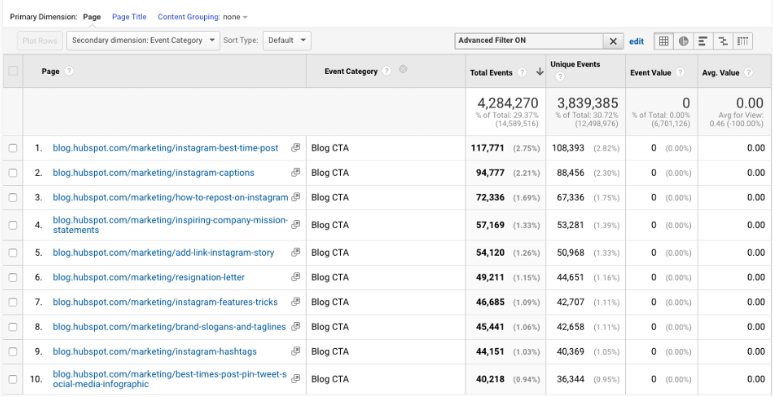
| Goal: Converions | Key metrics: Goals completed |
|---|
Conclusion
Good content takes planning. It culminates time, effort, diligence and consistency, and knowing what interests your target audience.
You also need creativity and ingenuity to keep your material fresh and engaging to pull off any measure of success.
Level up your content game by using the tips outlined in this guide, and start to enjoy the game-changing benefits and returns that come from consistently creating high-converting content.
Written by
Tahlia Reynolds





